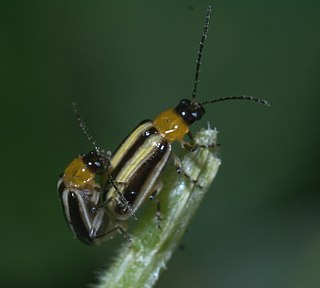
The flea beetle is a small, jumping beetle of the leaf beetle family (Chrysomelidae), that makes up the tribe Alticini which is part of the subfamily Galerucinae. Historically the flea beetles were classified as their own subfamily.
Colaspoides is a genus of leaf beetles in the subfamily Eumolpinae. It is one of the largest genera in the subfamily, containing over 260 species worldwide. It is an extant genus but there is at least one species, C. eocenicus, found in Baltic amber from the Upper Eocene of Russia, and the genus has also been reported from the Miocene of the Dominican Republic.

Galerucini is a tribe of skeletonizing leaf beetles in the family Chrysomelidae. There are more than 70 genera and at least 480 described species in Galerucini.

Paria is a genus of leaf beetles in the subfamily Eumolpinae. There are about 40 described species in Paria in North and South America, 19 of which are known north of Mexico. The genus is very similar to Typophorus.

Brachypnoea is a genus of leaf beetles in the subfamily Eumolpinae. It is mostly found in the Neotropical realm, though there are also eight known species in the Nearctic realm.

Eumolpini is a tribe of leaf beetles in the subfamily Eumolpinae. It is the largest tribe in the subfamily, with approximately 170 genera found worldwide. Members of the tribe almost always have a longitudinal median groove on the pygidium, which possibly helps to keep the elytra locked at rest. They also generally have a subglabrous body, as well as appendiculate pretarsal claws.

Luperini is a tribe of skeletonizing leaf beetles in the family Chrysomelidae. There are more than 30 genera and 500 described species in Luperini.

Rhabdopterus is a genus of leaf beetles in the subfamily Eumolpinae. There are about 70 described species in Rhabdopterus from North and South America, eight of which are found north of Mexico. The Nearctic species may not be congeneric with the type species, which is South American.
Spintherophyta is a genus of leaf beetles in the subfamily Eumolpinae. Most species in the genus are found in Central and South America, but there are also a few North American species.

Typophorini is a tribe of leaf beetles in the subfamily Eumolpinae. The tribe contains approximately 100 genera, which are found worldwide. Members of the tribe are mainly characterized by notches on the tibiae of the middle and hind legs, which are sometimes referred to as antenna cleaners. They also generally have a subglabrous body, as well as bifid pretarsal claws.
Metaxyonycha is a genus of leaf beetles in the subfamily Eumolpinae.
Allocolaspis is a genus of leaf beetles in the subfamily Eumolpinae.
Antitypona is a genus of leaf beetles in the subfamily Eumolpinae. It is found in Central America and South America.
Hylax is a genus of leaf beetles in the subfamily Eumolpinae. It is distributed in Central America and South America.
Habrophora is a genus of leaf beetles in the subfamily Eumolpinae. It is distributed in Central America, South America, and the West Indies. It is placed in the tribe Habrophorini with the related genus Psathyrocerus.

Isotes is a genus of skeletonizing leaf beetles in the family Chrysomelidae. There are currently about 180 described species in Isotes. They are found in the Neotropics.

Walterianella is a genus of flea beetles in the family Chrysomelidae. There are more than 40 described species in Walterianella. They are found in Central and South America.








